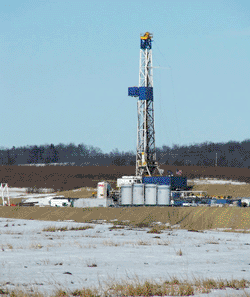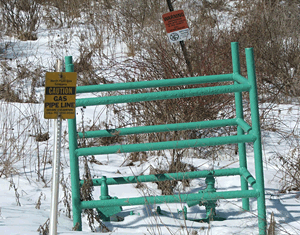
(Courtesy Tim Murtha)
On the North Branch of Pennsylvania's Susquehanna River, roughly an hour northwest of Scranton, sits Friedenshuetten. Meaning "tents of peace," the village was an eighteenth-century utopia founded by a Moravian missionary. There, both expats from what is now the eastern Czech Republic and Native Americans of the Eastern Delaware Nation coexisted in log cabins and wigwams from 1763 until 1772 when simmering distrust dissolved the settlement.
Archaeologists from Kings College in Wilkes-Barre began excavating the site in 1972, finding pieces of pipes, flints, and remains of a hearth, among other artifacts. The following year they uncovered the village's main core.
Today, situated amid the village's remains are two installations courtesy of Chesapeake Energy, the U.S.'s second largest producer of natural gas. One is a set of interpretive panels that explain the significance of the site. The other is a pipeline.
Back in the mid-1980s, Pennsylvania historical societies first identified the natural gas industry as a threat to archaeological sites. At the time, the warning just covered conventional well drilling. But, over the past five years, exploration of the Marcellus Shale formation, which extends from upstate New York to Tennessee, has ramped up. New developments in hydraulic fracturing, or "fracking"— the injection of millions of gallons of a fluid mixture made up primarily of water and sand into the shale—allow companies to extract greater quantities of methane trapped within the rock. The practice opens up areas where it was previously not feasible to retrieve natural gas. The resulting gas rush could further encroach on Pennsylvania's archaeological history thanks to minimal regulatory oversight from Harrisburg.
"It's a beautiful example of totally screwed up priorities," says Katherine Faull, a professor of German and the humanities at Bucknell University who uncovered a map of Friedenshuetten in a Moravian church in Germany, which she translated, annotated, and published in 2009. When she discusses Friedenshuetten today, her voice carries an air of exasperation. "There's nobody, it seems, who can say anything or stop the energy companies."
Faull's story echoes that of Bill Johnson, an independent archaeologist who, for 15 years, studied a southwestern Pennsylvania site where two different Monongahela villages (dating to A.D. 1300 and 1450, respectively) once stood. Unknown marauders in the early 1500s sacked the later settlement, burning its cache of corn and butchering several children—eating at least one of them. Johnson is still cataloging artifacts from the site, half of which, he discovered recently, has a drill rig on it. (The Archaeology Conservancy bought the other half in 2007.) "You assume," he says, "that the site is always going to be there."

(Courtesy Tim Murtha)
Two energy industry-friendly provisions on Pennsylvania's books make that a dangerous assumption. The first is the so-called "10-acre rule," wherein if a company applies to the state's Department of Environmental Protection for a permit on a project that will take up 10 or fewer acres of land, the Pennsylvania Historical & Museum Commission (PHMC) is not required to review the proposal to ensure the protection of archaeological sites, nor does it have to be notified. When a project does exceed that acreage, the PHMC is notified. However, thanks to a 1995 amendment to the state's history code known as "Act 70," passed under heavy pressure from the gas lobby, the PHMC must fund, or itself undertake, any excavations of previously recorded archaeological sites that exist where a permit is pending. "PHMC has a far smaller staff and fewer financial resources than in the past," says Doug McLearen, chief of the PHMC's Division of Archaeology & Protection. "We no longer conduct or fund
such excavations."
Act 70 makes PHMC's stewardship of Pennsylvania archaeology an "unfunded mandate," says Jason Espino, president of the Society for Pennsylvania Archaeology's Allegheny Chapter. With worries about increased fracking of the Marcellus Shale, Espino has heard stories of the gas industry's impact on Paleoindian sites in western Pennsylvania and sites that likely contained multiple settlements over time and contain artifacts dating from the early Archaic period, 9,000 years ago, up to the turn of the seventeenth century.
Espino is currently working toward a master's degree in applied archaeology at Indiana University of Pennsylvania. For his thesis, he's tracking 3,000 previously recorded sites in Washington County, where fracking in Pennsylvania first began in 2005. He notes that fracking requires less actual drilling than conventional wells (the high-pressure method is combined with horizontal drilling to create clustered networks of cracks that open up more of the formation to extraction). But each fracking operation affects five times as much land (10 acres versus two). He says that nearly 17,000 acres of land statewide were at risk of disturbance in 2010, compared to 10,000 acres in 2008. Acknowledging a need to balance economic and archaeological interests, he suggests allowing the PHMC to crossreference the locations for all proposed wells with the locations of known archaeological sites. "PHMC could then warn that wells might impact an archaeological site and recommend moving operations a couple hundred feet over to avoid them," he says. But Espino also acknowledges that the economic boon drilling represents to the state means there is little impetus in Harrisburg to alter the review process.
One approach that could mitigate harm to archaeological sites is to align the movement for their protection with the efforts of environmental groups. To date, concerns about groundwater contamination—by the chemicals used in and the methane released from fracking—have led to a moratorium on the process in both New York and New Jersey. Whereas some archaeologists worry that an alliance would lead to their interests being subjugated to environmentalists' concerns, Tim Murtha, an archaeologist at Penn State University, strongly disagrees. "Conservationists do a much better job at communicating the issues than we have," he explains. "We can't disentangle human history from natural history or environmental history, and it's that notion that should bring us together in terms of preservation."

